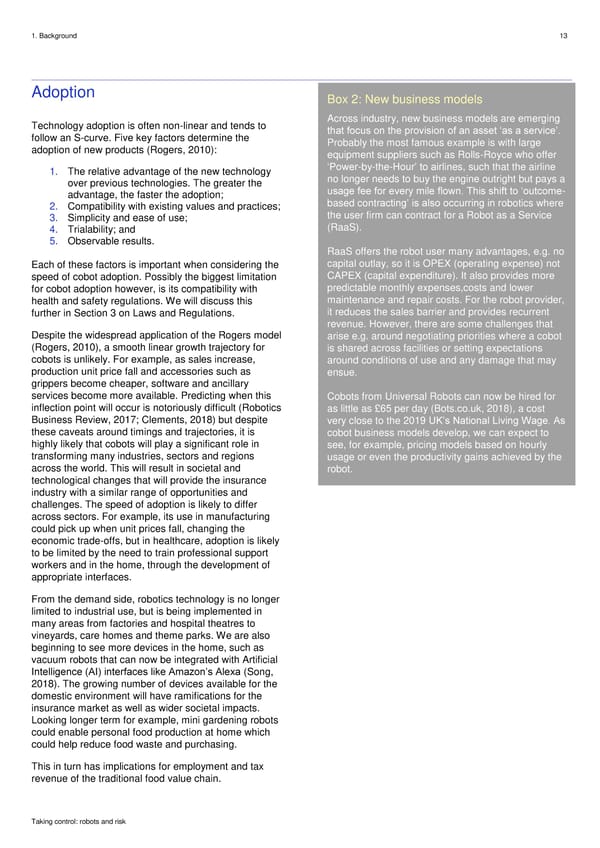1. Background 13 Adoption Box 2: New business models Technology adoption is often non-linear and tends to Across industry, new business models are emerging follow an S-curve. Five key factors determine the that focus on the provision of an asset ‘as a service’. adoption of new products (Rogers, 2010): Probably the most famous example is with large equipment suppliers such as Rolls-Royce who offer 1. The relative advantage of the new technology ‘Power-by-the-Hour’ to airlines, such that the airline over previous technologies. The greater the no longer needs to buy the engine outright but pays a advantage, the faster the adoption; usage fee for every mile flown. This shift to ‘outcome- 2. Compatibility with existing values and practices; based contracting’ is also occurring in robotics where 3. Simplicity and ease of use; the user firm can contract for a Robot as a Service 4. Trialability; and (RaaS). 5. Observable results. RaaS offers the robot user many advantages, e.g. no Each of these factors is important when considering the capital outlay, so it is OPEX (operating expense) not speed of cobot adoption. Possibly the biggest limitation CAPEX (capital expenditure). It also provides more for cobot adoption however, is its compatibility with predictable monthly expenses,costs and lower health and safety regulations. We will discuss this maintenance and repair costs. For the robot provider, further in Section 3 on Laws and Regulations. it reduces the sales barrier and provides recurrent revenue. However, there are some challenges that Despite the widespread application of the Rogers model arise e.g. around negotiating priorities where a cobot (Rogers, 2010), a smooth linear growth trajectory for is shared across facilities or setting expectations cobots is unlikely. For example, as sales increase, around conditions of use and any damage that may production unit price fall and accessories such as ensue. grippers become cheaper, software and ancillary services become more available. Predicting when this Cobots from Universal Robots can now be hired for inflection point will occur is notoriously difficult (Robotics as little as £65 per day (Bots.co.uk, 2018), a cost Business Review, 2017; Clements, 2018) but despite very close to the 2019 UK’s National Living Wage. As these caveats around timings and trajectories, it is cobot business models develop, we can expect to highly likely that cobots will play a significant role in see, for example, pricing models based on hourly transforming many industries, sectors and regions usage or even the productivity gains achieved by the across the world. This will result in societal and robot. technological changes that will provide the insurance industry with a similar range of opportunities and challenges. The speed of adoption is likely to differ across sectors. For example, its use in manufacturing could pick up when unit prices fall, changing the economic trade-offs, but in healthcare, adoption is likely to be limited by the need to train professional support workers and in the home, through the development of appropriate interfaces. From the demand side, robotics technology is no longer limited to industrial use, but is being implemented in many areas from factories and hospital theatres to vineyards, care homes and theme parks. We are also beginning to see more devices in the home, such as vacuum robots that can now be integrated with Artificial Intelligence (AI) interfaces like Amazon’s Alexa (Song, 2018). The growing number of devices available for the domestic environment will have ramifications for the insurance market as well as wider societal impacts. Looking longer term for example, mini gardening robots could enable personal food production at home which could help reduce food waste and purchasing. This in turn has implications for employment and tax revenue of the traditional food value chain. Taking control: robots and risk
 Robots & Risk Page 12 Page 14
Robots & Risk Page 12 Page 14